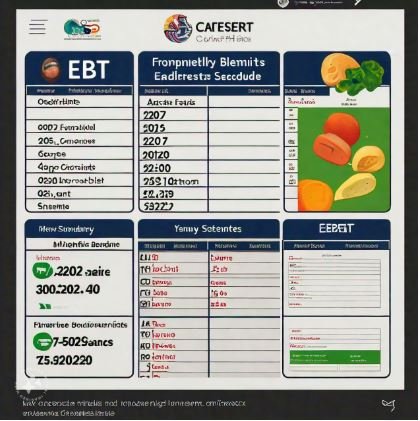For millions of low-income individuals and families, the Supplemental Nutrition Assistance Program (SNAP) provides crucial support through EBT benefits. These benefits help families purchase food, easing the burden of food insecurity. However, one aspect of the program that often raises questions is the monthly EBT benefits schedule. Is this schedule a reliable and predictable source of assistance, or does it create confusion and inconsistency for recipients? In this article, we will explore whether the monthly EBT benefits schedule delivers timely, consistent aid to families or whether it introduces challenges that hinder its effectiveness.

What is the Monthly EBT Benefits Schedule?
The monthly EBT benefits schedule refers to the specific dates each month when SNAP benefits are loaded onto the Electronic Benefit Transfer (EBT) card. These dates are determined by the state and are typically based on factors such as the last name of the primary recipient, household size, or the applicant’s case number. The monthly EBT benefits schedule varies by state, and each state has its own system for determining when the benefits will be available to recipients.
The goal of the monthly EBT benefits schedule is to provide a reliable system for distributing assistance. However, for many families, the timing of when their benefits are issued plays a significant role in their ability to manage their budgets effectively throughout the month.
Reliable Assistance or Inconsistent Delivery?
1. Predictability and Stability of the Schedule
For many recipients, the monthly EBT benefits schedule provides predictable assistance, offering a sense of stability. Knowing when benefits will arrive each month helps families plan their grocery shopping and household expenses. This predictability can be a lifesaver, especially for households with limited resources. In this sense, the monthly EBT benefits schedule serves as a reliable tool for ensuring that families have access to the food they need.
For example, some states issue benefits at the beginning of the month, while others may stagger them over several days or weeks. A set schedule makes it easier for recipients to anticipate when they will have access to their benefits, allowing them to better manage their food budgets. This regularity can help reduce anxiety, ensuring that families are not caught off guard by unexpected gaps in their food supply.
However, while the monthly EBT benefits schedule may be predictable for many, there are factors that contribute to inconsistency for others, especially in areas with fluctuating demand or issues related to processing and distribution.
2. Inconsistencies Between States
While the monthly EBT benefits schedule is generally designed to be reliable, one significant issue is the inconsistency between states. Each state administers its own SNAP program, meaning that the monthly EBT benefits schedule can differ widely based on where recipients live. For example, one state might issue benefits on the 1st of each month, while another might issue benefits from the 1st through the 10th, depending on the last name of the recipient.
These differences can lead to confusion, particularly for families who have recently moved between states or those who are unfamiliar with the local schedule. Recipients may not know exactly when their benefits will arrive, which can lead to challenges in managing food expenses effectively. In some cases, these inconsistencies between state schedules can create stress for families who rely on timely assistance to meet their basic food needs.
3. The Impact of Delays and Errors
One of the most significant drawbacks of the monthly EBT benefits schedule is the possibility of delays or errors in benefit distribution. Although the program is designed to provide regular support, occasional technical issues or delays in processing can result in recipients not receiving their benefits on the scheduled date. This can cause serious problems for families who rely on their EBT card for food purchases.

For example, a family that typically receives their benefits on the 5th of the month might experience a delay due to system errors or administrative issues, leaving them without food assistance until the problem is resolved. These delays are particularly problematic for families who may not have other resources available to tide them over. The inconsistency in benefit delivery can create financial strain, forcing families to rely on food banks or other emergency resources.
Unfortunately, these issues are not always addressed quickly. In some cases, recipients may need to wait days or even weeks for the issue to be resolved, creating uncertainty and hardship.
4. Staggered Benefits: A Double-Edged Sword
Some states stagger the monthly EBT benefits schedule to distribute benefits over a longer period rather than issuing them all at once. On the surface, this system is intended to reduce overcrowding at grocery stores and ensure that there is a steady flow of benefits throughout the month. While this might seem like a reasonable solution, it can lead to problems for recipients.
For families who rely on a single, lump sum of benefits to make all their purchases for the month, receiving a portion of their benefits at a time may complicate their budgeting. For example, a family may need to wait until later in the month to access the rest of their benefits, forcing them to make do with limited resources until the full amount is available. In these cases, the monthly EBT benefits schedule may not be as reliable as families would prefer.
Additionally, staggered benefits can lead to situations where families are uncertain about how much they have left on their EBT cards, creating further confusion and preventing them from planning their purchases effectively. While some families might find the staggered approach convenient, others may struggle with the inconsistent nature of this system.
5. Emergency Assistance and Special Circumstances
Another important consideration is how the monthly EBT benefits schedule interacts with emergency situations or special circumstances. In times of crisis—such as natural disasters, economic downturns, or global health emergencies—some families may need immediate access to food assistance outside of the regular monthly EBT benefits schedule.
While the SNAP program does offer emergency assistance in certain situations, the ability to access these benefits can vary depending on the circumstances. If a family faces a sudden crisis but has already used up their monthly benefits, they may have to wait until the next scheduled benefit period or apply for emergency SNAP benefits, which can take time to process.
This reliance on a rigid monthly EBT benefits schedule may leave vulnerable families in difficult situations, especially during emergencies when fast and flexible support is needed.

Conclusion: Reliable Assistance or Inconsistent Delivery?
In conclusion, the monthly EBT benefits schedule offers both reliable assistance and potential barriers. On the one hand, the predictability of benefit delivery can help families plan their budgets and provide stability throughout the month. For many, the monthly EBT benefits schedule serves as a dependable source of support, ensuring that they have access to the food they need.
However, the inconsistency between states, the possibility of delays and errors, and the challenges posed by staggered benefits all contribute to the less reliable aspects of the monthly EBT benefits schedule. For some families, these issues create confusion, frustration, and hardship, particularly when they face financial strain or emergencies.
Ultimately, the monthly EBT benefits schedule is a vital tool for providing food assistance to low-income families, but improvements could be made to ensure that benefits are delivered more consistently and equitably across all states. Addressing issues like delays, offering clearer guidance, and improving emergency response systems could help make the monthly EBT benefits schedule more reliable for families in need.




